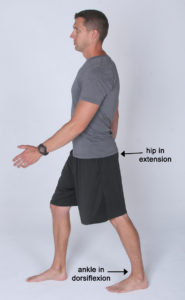How can the hip-flexors cause foot pain you wonder? Let’s start at the foot and ankle to understand the connection.
One of the most common musculoskeletal imbalances that affects the correct functioning of the foot and ankle that can lead to pain is a lack of dorsiflexion. A lack of dorsiflexion is characterized by the inability of the ankle to bend forward in order for the lower leg to travel over the foot correctly. When weight is not transferred forward into the foot the ankle collapses inwards, the structures of the foot (i.e., arches) do not engage, the toes do not spread out and all the wonderful supportive mechanisms of the foot that help the body balance and transfer weight forward do not work correctly.
 Hip Flexors Can Cause Foot Pain
Hip Flexors Can Cause Foot Pain
Two of the most important muscle groups in the lower body that help promote dorsiflexion are the calf muscles and hip flexors. The posterior calf muscles such as the soleus and gastrocnemius must be flexible to allow the shin bones to come forward over the foot (i.e., dorsiflex). Similarly, the hip flexors must also be flexible to allow the leg to come forward over the foot effectively. They work in conjunction with the calf muscles and structures of the foot and ankle to allow dorsiflexion. For example, when a person is walking, the hip flexors of the weight bearing leg stretch under tension (i.e., the hip goes behind the body) as the load of the person’s body weight travels forward over their foot (see image). As such, correct function of the hip flexors is inherently linked to dorsiflexion. Therefore, next time you have foot/ankle pain (or a client complains of a similar problem) make sure you include exercises that increase the mobility of the hip flexors (i.e., hip-flexor stretches and SMR) so that they can lengthen effectively (along with the calf muscles) to help promote better dorsiflexion.
To learn a step-by-step process for helping clients overcome muscle and joint pain, check out The BioMechanics Method Corrective Exercise Specialist certification program that teaches you how to assess clients to uncover the root causes of their pain and dysfunction and how to target these issues with the appropriate application of corrective exercise.
